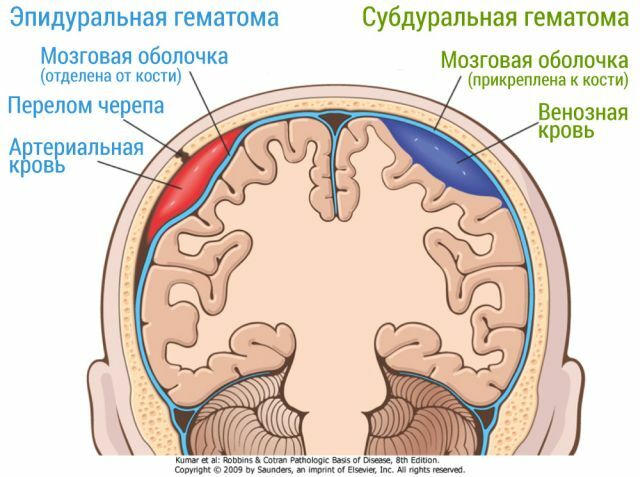 Subdural hematoma refers to a hemorrhage or an outflow of bloody fluid into the space between the solid and subarachnoid shells of the brain.
Subdural hematoma refers to a hemorrhage or an outflow of bloody fluid into the space between the solid and subarachnoid shells of the brain.
Subdural fraction accounts for approximately 40% of all intracranial hemorrhages. In the etiology of the disease, the traumatic aspect predominates, and its frequency directly depends on the severity of the injured craniocerebral trauma and in the case of severe TBT it ranges from 9 to 11%.
. Among the patients, men over 40 years old prevail, this disease also occurs in newborns and the elderly.
Contents
- Features
- Features
- Classification of formations
- Acute manifestations of hemorrhage
- Subacute hematoma
- Chronic course of
- About the causes of hematoma formation
- Patemychanism of violation
- Clinical picture
- Diagnostic methods
- What does the medicine offer?
Distinctive features of
As with other intracranial hemorrhages, with subdural hematoma( CG) the signs of general and local compression of the brain are paramount. Clinically, it is similar to epidural( EG), but is more common and has a number of significant differences from the latter:
- With subdural type, the blood extends between the subarachnoid and hard membranes. Epidural hematoma is localized in the lumen between the dura mater and the cranial bones.
- Subdural hemorrhage usually occurs as a result of a traumatic rupture of the bridging
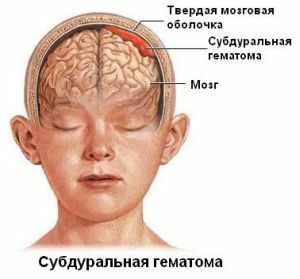 of bridging veins flowing into the sinuses. The source of bleeding with EG is arterial vessels( usually the middle meningeal artery and its branches), rarely sinuses( sigmoid, upper sagittal).
of bridging veins flowing into the sinuses. The source of bleeding with EG is arterial vessels( usually the middle meningeal artery and its branches), rarely sinuses( sigmoid, upper sagittal). - The gradual increase in symptoms characteristic of hypertension is explained by the venous type of bleeding and sufficient area for the discharge of blood. In turn, the epidural space is limited. Clinically, this type of hemorrhage is characterized by a light interval and, as a rule, a more turbulent course.
- For EG there is a one-sided localization, for subdural it is often two-sided, both in the place of impact and at the opposite pole.
- The CT picture is different: the hemorrhage between the cranial bones and the dura mater has the form of a biconvex lens, between the arachnoid and the solid - the crescent shape.
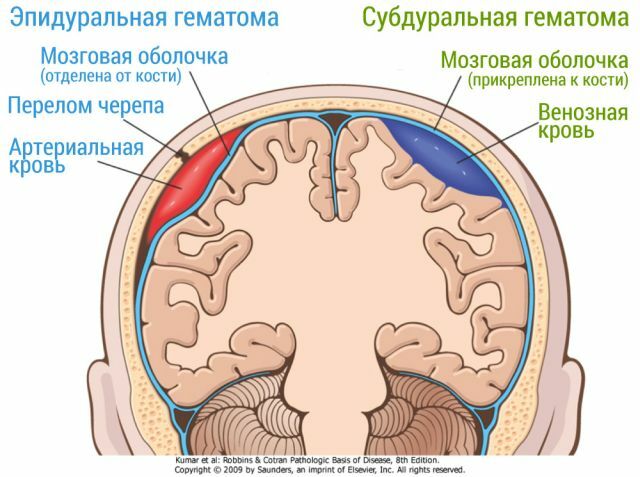
Classification of formations
Depending on the amount of blood flowed, the hematomas are divided into:
- small - up to 30 ml;
- medium - from 30 to 90 ml;
- large - more than 90 ml.
In relation to brain lesions:
- monoblore;
- bilobar;
- are polybilobular.
The division of subdural hematomas is clinically determined depending on the time of onset and the rate of increase in symptoms.
Acute manifestations of hemorrhage
Type of subdural hematoma of the brain, the clinical signs of which appear during the first three days after the effect of the provoking factor.
Current options:
- Classic - rare, usually accompanied by moderate to severe injuries, characterized by the gradualness: loss of consciousness at the time of injury;a bright interval, the duration of which is variable( from minutes to several days), during this period the complaints are insignificant and the focal symptomatology is usually absent;the deactivation of consciousness again, with the preceding unfolding of the clinic.
- With a poorly expressed period of relative well-being, - accompanies heavy TBI.Initially, a severe coma, a general cerebral and focal symptomatology is explained by damage to the brain substance as a result of a bruise. After a partial restoration of consciousness, accompanied by a clear clinic, a second loss occurs.
- Without the presence of the light gap - this type is the most common. The initial coma on the background of severe injuries does not change until the operation or death of the patient.
Subacute hematoma
 The clinic takes place between 4 and 14 days after injury.
The clinic takes place between 4 and 14 days after injury.
Initial symptomatology grows slowly, often resembles alcohol intoxication, meningitis, subarachnoid hemorrhage. In this regard, diagnosis is difficult.
There are three variants of the current:
- Classic - also characterized by three-phase( loss of consciousness, period of relative well-being, disturbance of consciousness again), but unlike acute hematoma the symptoms grow less violently and the clear interval is more pronounced.
- Without initial loss of consciousness .
- With the erased period of relative well-being of .
Chronic form of
Chronic subdural hematoma is detected after two weeks from the moment of injury. Its main feature, in addition to the weak manifestation of clinical manifestations in comparison with acute and subacute hematomas, is the formation of a capsule around the bleeding blood.
The most prognostically favorable type of hemorrhage.
On the causes of the formation of hematomas
In the etiology of the disease, the head injury received in an accident is predominant, with a fall or directional impact. There are also more rare causes of non-traumatic nature:
- Syndrome of child tremor - a pathological condition that occurs when tossing a small child and shaking
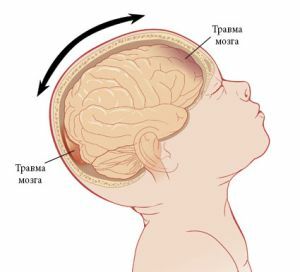 non-fixed head. The rupture of the bridging veins in this syndrome is associated with their considerable stretch due to the greater width of subdural space in children.
non-fixed head. The rupture of the bridging veins in this syndrome is associated with their considerable stretch due to the greater width of subdural space in children. - Application in the delivery of devices to extract the child forceps, birth injuries.
- The probability of rupture of venous vessels is increased in suffering from alcoholism, as well as in the elderly .In them, the expansion of the space between the subarachnoid and the dura mater is due to brain atrophy.
- With the age of , the risk of subdural hemorrhage increases against the background of arterial hypertension, atherosclerotic vascular lesions and their increased brittleness.
- Reduction of CSF pressure ( for example, with spinal puncture) in rare cases can also lead to an expansion of subdural space and rupture of the bridge veins.
- The presence of cysts of the subarachnoid membrane of the brain .
- Admission of a number of medications that reduce blood clotting ( anticoagulants, antiaggregants), diseases associated with vitamin K deficiency.
Pathomechanism of
violation. Subdural hematoma can develop on the background of trauma of varying degrees. With a significant damage accompanied by a fracture of the cranial bones, there is a picture of acute hematoma, subacute and chronic course is possible with less severe injuries.
As a rule, under the influence of the causative factor there is a rupture of a bridging vein flowing into the sine of the dura mater. The glowing lumen of the vessel becomes the place of blood flow. Accumulating, it provokes squeezing and swelling of the brain substance, the dislocation of its structures.
With a unilateral( homolateral) hematoma of a traumatic character, the area of application of force is small, and the head at the moment of trauma is stationary. This explains the limited vascular damage and local brain contusion.
 Contralateral damage to the brain structures is associated with a more serious trauma resulting from the collision of the movable head against a solid object( for example, when falling from a height).The displacement and bruise of the brain, the rupture of the vessels on the opposite side are also possible with a large area of application of force to the immovable head( for example, a collision with a falling tree).
Contralateral damage to the brain structures is associated with a more serious trauma resulting from the collision of the movable head against a solid object( for example, when falling from a height).The displacement and bruise of the brain, the rupture of the vessels on the opposite side are also possible with a large area of application of force to the immovable head( for example, a collision with a falling tree).
In addition, an indirect effect, as in the case of a sudden change in direction or speed, may also be the cause of rupture of the bridging veins and the formation of a hematoma.
A more rare mechanism of impairment is direct injury of sinuses and secondary hemorrhages against the background of dystrophy, necrosis or angioneurotic vessel changes.
Clinical picture
Symptomatic of the disease has its own peculiarities in each specific case and is largely dependent on the localization, volume and rates of hematoma growth. Significant impact on the nature of clinical manifestations of concomitant injury and brain damage, the age of the patient.
Dominated in the clinic:
- Complete loss of consciousness up to coma - in case of severe acute hematoma. Assessment of consciousness is made in points( from 0 to 15) based on the Glasgow coma scale.
- Symptoms of brainworm ( triad Cushing) - bradycardia, hypertension and loss of consciousness.

- Stem symptoms of - fluctuations in blood pressure, respiratory distress, hyperthermia, impaired tone and reflexes.
- Qualitative disorders of consciousness, mental disorders - delirious and onyroid, loss of memory, frontal behavior, euphoria, lack of criticism of one's own condition.
- Psychomotor agitation , development of generalized clonic-tonic convulsions .
- Headache - is usually bursting, irradiates into eyeballs, the back of the head, can be accompanied by repeated vomiting, photophobia, decreased vision.
- Meningeal signs of ( neck stiffness, positive symptoms of Kernig, Brudzinsky).
Focal symptomatology:
- dilated pupil( mydriasis) on the side of hemorrhage with decreased response to light, often accompanied by ptosis( eyelid drooping) and impaired mobility of the eyeball;
- movement disorders of the extremities on the opposite side of the body( paresis, plethia);
- focal seizures;
- pathological reflexes( Babinsky, reflexes of automatism);
- depending on the area of brain damage - sensitivity disorders, speech( motor, sensory aphasia), smell( hypo-anosmia), loss of visual fields, etc.
Diagnostic methods
The diagnosis of the disease is based on a thorough examination of the anamnesis( the nature and duration of the injury), patient complaints( time of onset, progression of symptoms).In the case of the unconscious state of the victim, a survey of eyewitnesses is conducted.
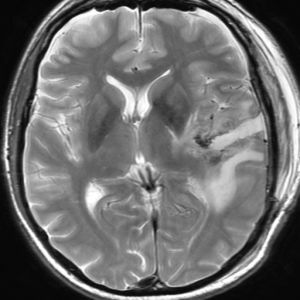 A general examination is required, revealing traces of trauma on the skull( abrasions, bruises, bone defects), is rejected.
A general examination is required, revealing traces of trauma on the skull( abrasions, bruises, bone defects), is rejected.
Neurological examination allows to diagnose deviations in the neurological status, the appearance of pathological reflexes, classical focal symptoms( mydriasis, hemiplegia, etc.), bloody cerebrospinal fluid with spinal puncture. Identification of signs of dislocation and wedging of brain structures becomes a contraindication to the procedure.
From the side of the organ of vision, stasis on the fundus, edema of the optic nerve, its atrophy( depending on the severity and duration of the trauma) can be observed.
In the diagnosis of hemorrhages, instrumental research methods are inherent:
- Brain CT of the brain is the most reliable method in the acute period of the disease, it allows early detection of a hyperechoic portion of the crescent shape in the projection of the brain. In the case of chronic hematoma, it is possible to diagnose signs of increased intracranial pressure and displacement of brain structures.
- MRI - variants with the introduction of contrast are used in doubtful situations and in diffodiagnosis with cysts and hygromas.
- EEG - reveals the median displacement of the brain structures.
- Radiography of the skull - performed to identify fractures of the base and the cranial vault.
What does medicine offer?
The management of patients depends primarily on the volume of the hematoma and its growth in dynamics.
Conservative treatment is possible with a small( up to 25 ml) hemorrhage, provided the patient's condition is stable and the possibility of dynamic control( neuroimaging by CT, MRI).It is also carried out as an element of preoperative preparation. The main goal in this case is a decrease in intracranial hypertension, a warning of wedging.
Basic methods and methods: 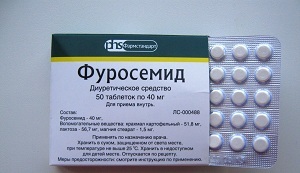
- the correct position of the patient with an elevated head end within 30-45º, facilitating the outflow of venous blood from the cranial cavity;
- anti-edema therapy - osmotic( Mannitol) and loop diuretics( Furosemide), metabolic drugs;
- oxygen therapy;
- mechanical ventilation with increasing respiratory failure and depression( Glasgow coma scores below 9 points);
- maintenance of the cardiovascular system( systolic pressure within 110-120 mm Hg).
Surgical intervention is indicated in the following situations:
- is a subdural hematoma( more than 25 ml in volume) that causes a displacement of the brain structures;
- smaller hemorrhage in the case of progressive deterioration of the patient;
- subacute or chronic hematoma of significant volume, provoking clinical symptoms.
 The essence of the operation lies in the imposition of trepanation milling holes, drainage of the bleeding through the resulting defect of the bone, and also thorough haemostasis. Due to external emptying of the hematoma, the brain decompresses and eliminates intracranial hypertension.
The essence of the operation lies in the imposition of trepanation milling holes, drainage of the bleeding through the resulting defect of the bone, and also thorough haemostasis. Due to external emptying of the hematoma, the brain decompresses and eliminates intracranial hypertension.
Acute subdural hematoma of the brain is certainly life-threatening condition, which is characterized by a high probability of death, including after a timely surgical treatment.
The prognosis is burdened by such complications as brain displacement, its secondary ischemia and edema. Prevention is the prevention of injuries, both domestic and in the workplace.


